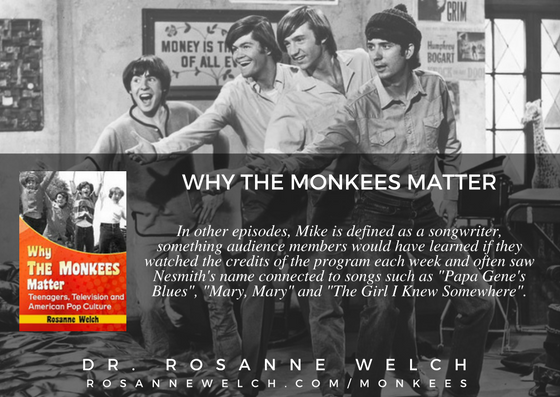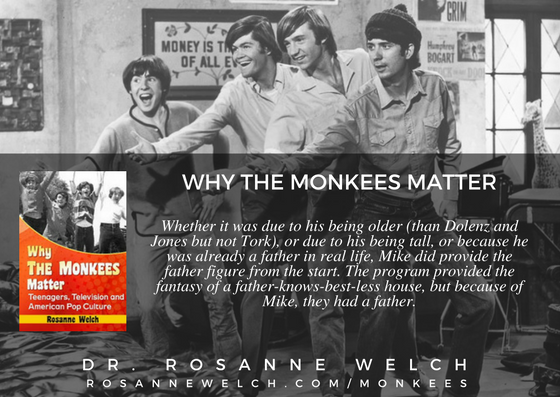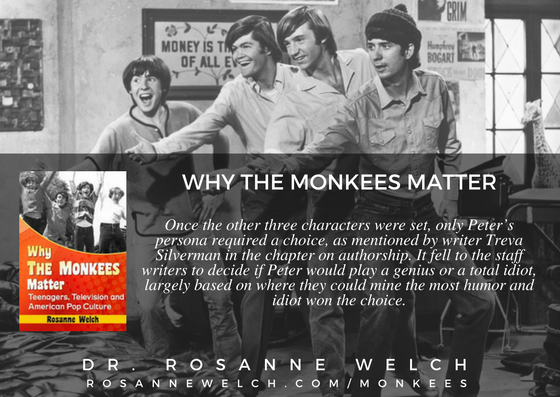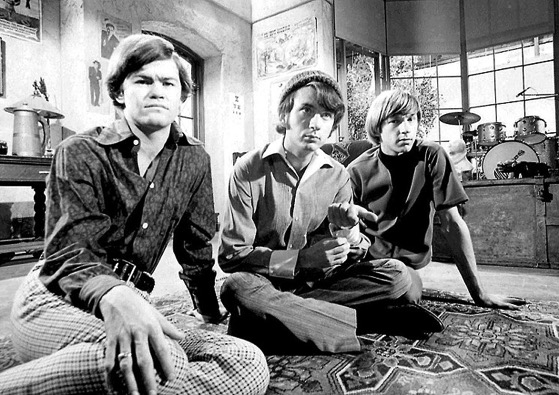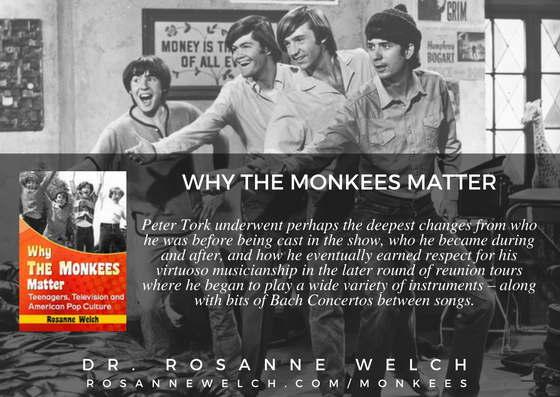Why The Monkees Matter: Teenagers, Television and American Pop Culture
Category: Monkees
From The Research Vault: From Circus Boy to singing Monkee, Micky Dolenz endures over the decades, AXS, Barbara Nefer, July 7, 2014
Quotes from “Why The Monkees Matter” by Dr. Rosanne Welch – 88 in a series – Mike The Songwriter
** Buy “Why The Monkees Matter” Today **
In other episodes, Mike is defined as a songwriter, something audience members would have learned if they watched the credits of the program each week and often saw Nesmith’s name connected to songs such as “Papa Gene’s Blues”, “Mary, Mary” and “The Girl I Knew Somewhere”.
from Why The Monkees Matter by Dr. Rosanne Welch — Buy your Copy today!
Why The Monkees Matter: Teenagers, Television and American Pop Culture
McFarland (Direct from Publisher) | Amazon | Kindle Edition | Nook Edition
From The Research Vault: College Enrollment Levels, National Center for Education Statistics 1968-1998
Quotes from “Why The Monkees Matter” by Dr. Rosanne Welch – 87 in a series – Mike the Father Figure
** Buy “Why The Monkees Matter” Today **
Whether it was due to his being older (than Dolenz and Jones but not Tork), or due to his being tall, or because he was already a father in real life, Mike did provide the father figure from the start. The program provided the fantasy of a father-knows-best-less house, but because of Mike they had a father.
from Why The Monkees Matter by Dr. Rosanne Welch — Buy your Copy today!
Why The Monkees Matter: Teenagers, Television and American Pop Culture
McFarland (Direct from Publisher) | Amazon | Kindle Edition | Nook Edition
From The Research Vault: Peter Tork at peace with post-Monkees career, The Morning Call, June 2, 2012
Quotes from “Why The Monkees Matter” by Dr. Rosanne Welch – 86 in a series – Peter the Idiot
** Buy “Why The Monkees Matter” Today **
Once the other three characters were set, only Peter’s persona required a choice, as mentioned by writer Treva Silverman in the chapter on authorship. It fell to the staff writers to decide if Peter would play a genius or a total idiot, largely based on where they could mine the most humor and idiot won the choice.
from Why The Monkees Matter by Dr. Rosanne Welch — Buy your Copy today!
Why The Monkees Matter: Teenagers, Television and American Pop Culture
McFarland (Direct from Publisher) | Amazon | Kindle Edition | Nook Edition
From The Research Vault: Musical Comedy’s Latest Revival Owes a Lot to the Monkees. Dan Moore, Phoenix New Times, August 8, 2013
The Journal of American Culture reviews “Why The Monkees Matter”
It was lovely to read another supportive review of Why The Monkees Matter – this one by Derham Groves writing for The Journal of American Culture. Happily, I had the pleasure of meeting with Derham when he was in Los Angeles for a conference. We shared a lovely dinner at the Hollywood/Highland complex while he told me the plans for a Monkees 50th anniversary of their concert tour of Australia at his home base, the Melbourne University library. If you live in Melbourne, check it out. — Rosanne
The publication of Why The Monkees Matter: Teenagers, Television, and American Pop Culture by Rosanne Welch happily coincided with the fiftieth anniversary of The Monkees—both the TV show and the pop group. In response to casting calls in The Hollywood Reporter and Daily Variety in 1965, American performers Mike Nesmith (b. 1942), Peter Tork (b. 1942), and Micky Dolenz (b. 1945) and English performer Davy Jones (1945-2012) were plucked from the 400 hopefuls who answered the ads to play the four members of a fictitious, struggling, garage band in a new teen comedy TV series, both to be called The Monkees. While Nesmith and Tork were unknown to the general public, Dolenz (as Mickey Braddock) had starred as “Corky” in the TV series Circus Boy (19561958), and Jones had played “The Artful Dodger” in the original Broadway production (1963) of the musical Oliver! The Monkees TV series ran from 1966 to 1968, while The Monkees pop group broke up in 1971, then reformed again in 1989.
Many critics and historians who have discussed The Monkees in the past have focused mostly on the group’s music, whereas Welch focuses mostly on the TV series. However, it is almost impossible to separate one from the other. The way in which The Monkees was formed standard for the cast of a TV show but seen by many as “inauthentic” for the members of a band—casts doubts about the musicianship of Nesmith, Tork, Dolenz, and Jones (unfairly, both Welch and I agree). When The Monkees toured Australia in 1968 (I was twelve years old and remember it very well), a TV reporter in Brisbane impertinently asked Jones: “When do you think you might break up and try something like music?” Jones responded by throwing a glass of water in the reporter’s face, to which he retaliated by doing likewise to Jones. (The Canberra Times, 23 September 1968).
Welch was right not to get bogged down too much by the controversy over the merit of The Monkees’ music, which is surely “old hat” anyway. Firstly, at least three of the group’s hits “I’m a Believer” (1966), “Last Train to Clarksville” (1966), and “Daydream Believer” (1967)—are widely recognized nowadays as “standards” of the era. Secondly, the two manifestations of The Monkees have both stood the test of time: the TV show has endured thanks initially to reruns, then to DVD, and now to YouTube; while the pop group’s three surviving members continue to perform into their seventies, most recently in 2016 to celebrate their fiftieth anniversary.
The four actor—musicians were hired to essentially play caricatures of themselves on The Monkees. This was underpinned by the decision to use their own given names on the show, that is, “Mike,” “Peter,” “Micky,” and “Davy.” As such, The Monkees were following a tradition established by some of America’s greatest comedians, including Jack Benny, Burns and Allen, Laurel and Hardy, Lucille Ball, and The Three Stooges. But The Beatles had the greatest effect on The Monkees. The English pop group influenced The Monkees’ zoomorphic name and the cute misspelling of “monkeys”; the group’s gender and size and particular mix of personalities; and the group’s zany antics on the TV show, which were modeled on those of The Beatles in their hit films, A Hard Day’s Night (1964) and Help! (1965). Coincidentally, Davy Jones and the Broadway cast of Oliver! performed on The Ed Sullivan Show on the same night in 1964 as The Beatles did. “I watched The Beatles from the side of the stage,” Jones recalled. “I saw the girls going crazy, and I said to myself, ‘This is it, I want a piece of that'” (Los Angeles Times, 1 March 2012).
Each chapter of Why The Monkees Matter looks at a different aspect of the TV series, such as its contribution to American counterculture in the 1960s; how feminism, gender, and sexuality were played out on the show; the role the scriptwriters played in making The Monkees a success; how the personalities of “Mike,” “Peter,” “Micky,” and “Davy” evolved over the course of the TV series’ two seasons and fifty-eight episodes and so on. But a constant theme throughout Welch’s book is metatextuality on The Monkees, that is, the two levels of dialogue that were going on one between the actor—musicians on the set and the other between the actor—musicians and the TV audience. While this was nothing new on television (Jack Benny and George Burns, mentioned above, both often interrupted the action to directly speak to or look at the TV audience), The Monkees introduced metatextuality to a new generation and, what is more, did it in fresh new ways, such as including outtakes at the end of the shows. While this is regularly done nowadays, it was rather “shocking” in 1966—and certainly very “hip.”
—Derham Groves, University of Melbourne
Why The Monkees Matter: Teenagers, Television and American Pop Culture
McFarland (Direct from Publisher) | Amazon | Kindle Edition | Nook Edition
Quotes from “Why The Monkees Matter” by Dr. Rosanne Welch – 85 in a series – Peter Tork
** Buy “Why The Monkees Matter” Today **
Peter Tork underwent perhaps the deepest changes from who he was before being cast in the show, who he became during and after, and how he eventually earned respect for his virtuoso musicianship in the later round of reunion tours where he began to play a wide variety of instruments – along with bits of Bach Concertos between songs.
from Why The Monkees Matter by Dr. Rosanne Welch — Buy your Copy today!
Why The Monkees Matter: Teenagers, Television and American Pop Culture
McFarland (Direct from Publisher) | Amazon | Kindle Edition | Nook Edition



